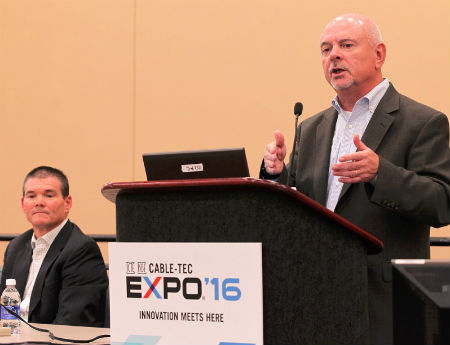Cable-Tec Expo: DOCSIS 3.1 Working As Advertised

Get complete coverage of Cable-Tec Expo 2016
Philadelphia – The DOCSIS 3.1 era is in its early days, but the results so far indicate that the new multi-gigabit platform for HFC networks is delivering as promised when it comes to producing gigabit-class speeds alongside improved bandwidth-efficiency.
All 3.1-based modems have shown they can support a Gigabit-class service, initially in the downstream path, no matter the modulation profile that the device is using, Jorge Salinger, vice president of access architecture at Comcast, explained, adding that the MSO has plans to support a D3.1-enabled upstream further out.
RELATED: DOCSIS 3.1 In The Wild
As a quick recap, DOCSIS 3.1 is designed to be 50% more bandwidth efficient (from a bits per hertz per second perspective) than DOCSIS 3.0 via the use of blocks of tiny OFDM (Orthogonal Frequency Division Multiplexing) subcarriers in tandem with an improved forward error correction scheme called Low Density Parity Check (LDPC).
Comcast now has “hundreds” of customers online with DOCSIS 3.1 in markets such as Nashville, Chicago and Atlanta, where Comcast is conducting advanced market trials of the technology, he said.
RELATED: Comcast Launches DOCSIS 3.1 Trial in Nashville
The smarter way to stay on top of the multichannel video marketplace. Sign up below.
That’s important to know, because DOCSIS 3.1 modems and cable modem termination systems (CMTSs) can dynamically tap into multiple “modulation profiles” (up to 4086 QAM) depending on the condition of the spectrum they’re using. The use of tiny OFDM (Orthogonal Frequency Division Multiplexing) subcarriers for DOCSIS 3.1 enables operators to shift to different modulation profiles depending on the signal-to-noise ratio that’s present in the spectrum.
Operators will be set up to set up multiple profiles that can be adjusted “multiple times per day” as new automated tools to manage them enter the market, Salinger said, noting that 3.1 modems are set up for five modulation profiles (four, plus one for testing), while CMTSs can handle 16 modulation profiles per downstream per service group.
The initial trials show that OFDM signals delivered on HFC networks are performing well, Salinger said.
As for the speeds delivered, Comcast’s initial work also showed that it can easily achieve 1 Gbps-plus speeds by aggregating traffic from 24 DOCSIS 3.0 single-carrier QAM channels (about 900 Mbps) with a 96 MHz block of DOCSIS 3.1/OFDM traffic (about 800 Mbps).
Midco has also seen promising results from its early D3.1 trial work in Fargo, N.D., the first top of many as the MSO looks to offer gigabit speeds to all subscribers by the end of 2017.
RELATED: Midco Preps for DOCSIS 3.1, Gigabit Speeds
DOCSIS 3.1 “worked well in the lab, it worked well in the field,” Jason Miller, technical marketing engineer at Cisco Systems, which has been working with Midco on the trial, said.
In the Fargo trial, Midco used a 144 MHz block of OFDM combined with eight DOCSIS 3.0 single carrier QAM channels and produced sustained downstream speeds of about 1.57 Gbps.
Jay Rolls, SVP and CTO at Charter Communications and session moderator, wondered if operators will need a legion of DOCSIS 3.1 gurus to operationalize DOCSIS 3.1.
Salinger stressed that MSOs will need to adjust their operations for DOCSIS 3.1, particularly in areas such as installation and maintenance.
Salinger acknowledged that setting up multiple modulation profiles is a “daunting task,” noting that it takes time -- sometimes a week -- to do that by hand, “and we’re good at it.”
However, he said tools are being created to automate that process on a continual basis, and expects them to be ready for deployment this quarter.
